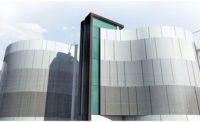Jim Nickerson, project manager for Vegas Tunnel Constructors, says the unseen geologic conditions forced the crews—comprising 100 people working 24 hours a day in three shifts—to operate the TBM in closed mode more often than anticipated.
"We had planned a maximum of 30% of tunneling in the more difficult closed mode. It ended up being almost 60%," Nickerson says.
The rate of progress varied, depending on geologic conditions and how fast crews could get materials down the access shaft. In open mode, daily progress ranged from 20 ft to more than 100 ft; in closed mode, progress ranged from a few inches to up to 70 ft. Due to the varied progress, timing became an additional challenge, according to team members.
"The TBM progress is based on the logistics of supplying that TBM with the footage we were getting that day," Nickerson says. "All of those materials, the segments, the grout, the rail, the piping extensions—all of that had to be lowered down a 600-ft shaft, then hauled by locomotive to the TBM."
North of the launch chamber is the starter tunnel, a 360-ft-long, 26-ft-wide opening. An umbrella canopy system was used to allow for sequential excavation and mitigate adverse geologic conditions in the area.
"One of the biggest [challenges] was that the original alignment for the tunnel had to be moved about 23° because a deposit of clay-rich deposits were found," Moonin says.
As a result of the tunnel alignment delay, the custom-designed, 23.6-ft-wide, 600-ft-long, multi-mode German-made Herrenknecht TBM sat unassembled at the top of the access shaft for more than a year while contractors completed planning for the new alignment and additional excavations. The machine was launched in late 2011.
The TBM is still being removed from the intake, although that process is nearly complete.
Beyond the Intake
Lake Mead Intake No. 3 is expected on line by year-end, connected at first to a decades-old pumping station. In May, preconstruction services are set to begin on the adjacent new Low Lake Level Pumping Station, to be built on a debris pile about a football field's distance away from the intake's tunnel access shaft.
While the MWH-CH2M engineering joint venture proceeds, the project's construction manager-at-risk is expected to be named this spring. Work includes construction of a 20-ft-wide, 525-ft-deep shaft, a large underground forebay, 33 well shafts, deep-submersible pumps, a motor control center, and electrical and other utility service connections.
The pumping station originally was planned to be developed in tandem with the intake, but it was delayed by budget cutbacks during the recession. Moonin says the delay allowed participants to develop better pumps.







